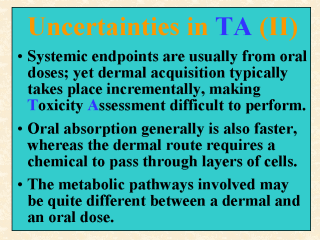 |
In many
instances, the systemic endpoint of concern observed in the test animal was from oral dose
(as from a feeding study). Yet even when a reliable absorption rate can be obtained to
extrapolate absorbed dose from an applied dermal dose, there is still an uncertainty about
the exact impact of this dermally absorbed dose compared to the toxicity (reference) dose
absorbed via the oral route. Ross et al. (2000) provide a fair discussion on the
potential overestimation from bolus (oral) dose to nonbolus (dermal) dose. Human dermal
(and even inhalation) acquisition typically takes places incrementally over the entire
(work)day, whereas an oral absorbed dose can be completely acquired by test animals in
minutes to less than an hour. In addition to this slower dermal acquisition, the rate of
dermal absorption is typically lower than that of oral absorption. As Rozman and Klaassen
(1996) point out, this absorption difference is due in part to the fact that absorption by
the dermal route requires a chemical to pass through several densely packed epidermis
cells. In contrast, the intestine's large number of villi and microvilli increases the
oral absorption surface area approximately 600-fold. Rozman and Klaassen also assert that
it is the concentration of a chemical at the site of action, not the total (absorbed)
dose, that ultimately determines toxicity. Complicating these acquisition and absorption
incompatibilities further is the possibility that a dermal dose might not undergo the same
series of critical metabolic pathways as an oral dose does. |
